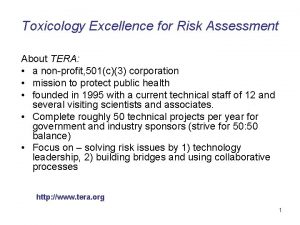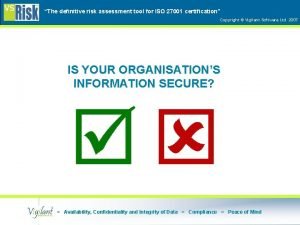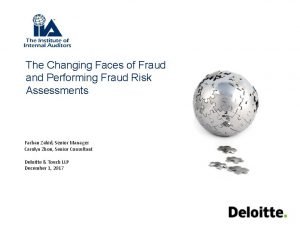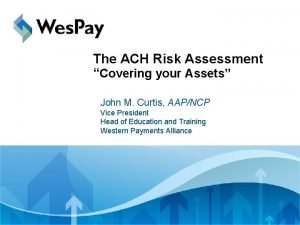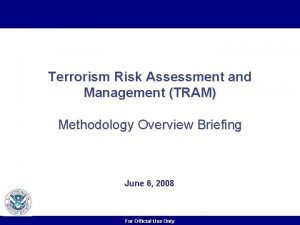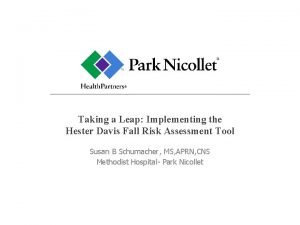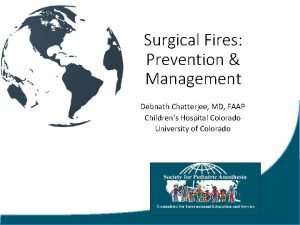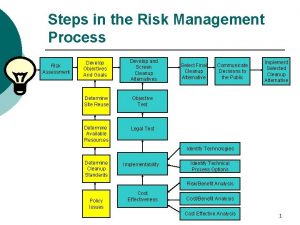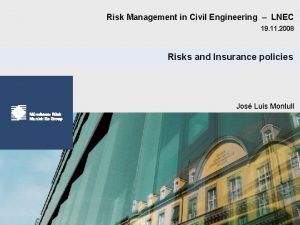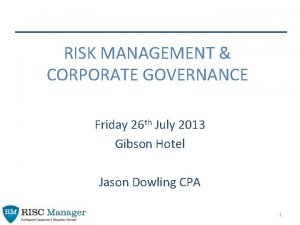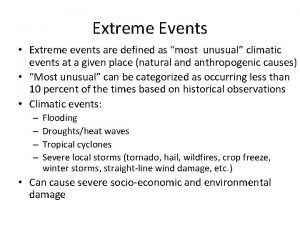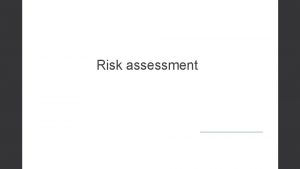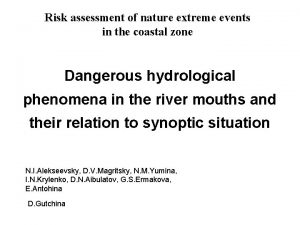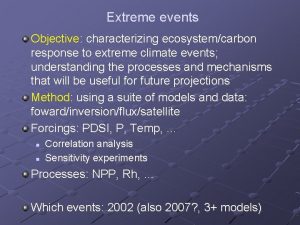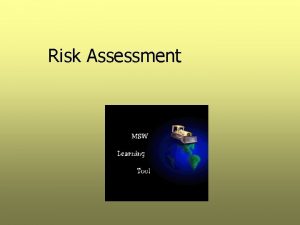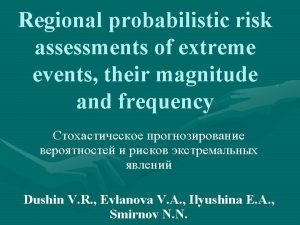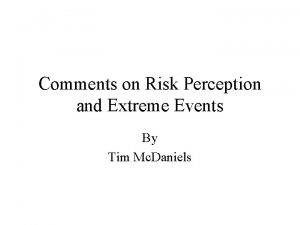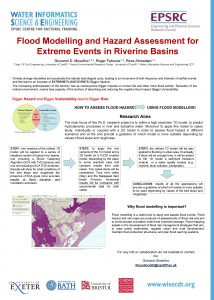Risk Assessment of Extreme Events 2 I Introduction































- Slides: 31


Risk Assessment of Extreme Events 2

I. Introduction and Scope • Risk assessment is a means to characterize and reduce uncertainty to support our ability to deal with catastrophe • Scope of this paper: – Application of risk assessment to both the built and natural environments under extreme events – Understanding and management of human health, safety, and security 3

I. Introduction and Scope (cont. ) • Modern risk assessment for engineering began with Reactor Safety Study (1975): – Applications to engineered systems and infrastructure are common • Applications to chemical risks under dozens of federal environmental statutes: – E. g. , drinking water, ambient water quality, and air quality standards – Review and renewal of pesticide applications – Levels of site cleanup under Superfund 4

II. What is Risk Assessment? • Definition of risk assessment: “A systematic approach to organizing and analyzing scientific knowledge and information for potentially hazardous activities or for substances that might pose risks under specified circumstances” National Research Council (NRC), 1994 5

II. A Definitions of Risk • “Both uncertainty and some kind of loss or damage” (Kaplan and Garrick 1981) • “The potential for realization of unwanted, negative consequences of an event” (Rowe 1976) • “The probability per unit time of the occurrence of a unit cost burden” (Sage and White 1980) • “The likelihood that a vulnerability will be exploited” (NRC 2002) 6

II. A Definitions of Risk (cont. ) • Terms to characterize acceptable risk in health and safety legislation: – – – – Adequate Imminent Substantial Reasonable (vs. unreasonable) Posing grave danger At a zero level Significant (vs. de minimus) An ample or adequate margin of safety 7

II. B Relationship of Risk to Other Concepts • Merriam-Webster’s Collegiate Dictionary 2002: – Hazard (“a source of danger”) – Catastrophe (“a momentous tragic event”) – Chronic (“long duration or frequent recurrence”) • NRC 2002: Threat (“an adversary”) – Vulnerability (“an error or a weakness”) • • • Extreme events (low frequency and high severity) Counter-expected events (believed to be unlikely) Unexpected events (not even anticipated) Uncertainty (lack of knowledge) Variability (differences among a population) 8

II. C Paradigms for Risk Assessment • A form of systems analysis • Answers three questions (Kaplan and Garrick 1981): – “What can go wrong? ” – “How likely is it that will happen? ” – “If it does happen, what are the consequences? ” • Several integrated risk assessment/risk management frameworks have been proposed 9

II. C Paradigms for Risk Assessment (cont. ) • “Deliberation frames analysis and analysis informs deliberation” (Stern and Fineberg 1996): – The combination of these two steps is termed the “analytic-deliberative” process – An iterative process – Deliberation and analysis are viewed as complementary 10

III. A Health Risk Assessment • Hazard identification • Risk estimation: – Exposure assessment – Dose/response relationships (toxicity assessment) – Risk characterization or risk calculation Columbia-Wharton/Penn Roundtable 11

III. A Health Risk Assessment (cont. ) • Hazard identification: – Structure activity relationships (structural toxicology) – Case clusters – Epidemiological studies – Experimental chemical tests on lower order organisms (rapid screening) – Animal tests Columbia-Wharton/Penn Roundtable 12

III. A Health Risk Assessment (cont. ) • Exposure assessment: – Sources, pathways, and sinks (or receptors) – Health effects assessment 13

III. A Health Risk Assessment (cont. ) • Sources, pathways, and sinks (receptors): – Source characterization (substances released, rates of release, temporal variations, location) – Fate and transport – Routes or pathways of exposure from environmental end points to human organisms – Size, type, and sensitivity of population at risk 14

III. A Health Risk Assessment (cont. ) – Health effects assessment: • Dose estimates or intake levels • Absorption by the body • General toxicity of the risk agent in the body (e. g. , target organs, types of effects) • State of health of the organism 15

III. A Health Risk Assessment (cont. ) • Dose/response relationships (toxicity assessment): – Dose/response models – Empirical relationships between levels of exposure and effects 16

III. A Health Risk Assessment (cont. ) • Risk characterization or calculation: – Risk estimate – Characterization of uncertainties, assumptions, and data quality 17

IIIB Engineering Risk Assessment • Hazard identification • Assessment of accident occurrence frequencies • Consequence analysis • Risk characterization • Uncertainty analysis 18

III. B Engineering Risk Assessment (cont. ) • Hazard identification: – System familiarization – Hazard and operability studies – Failure modes and effects analysis 19

III. B Engineering Risk Assessment (cont. ) • Assessment of accident occurrence frequencies: 20

III. B Engineering Risk Assessment (cont. ) • Consequence analysis has two stages: – Migration of hazardous materials from sources to sinks – Consequences of those materials for public health and safety • Relevant consequence measures include: – – Structural response of a building Costs of property damage, loss of use, repair Amount of hazardous material released Numbers of fatalities or other health effects 21

III. B Engineering Risk Assessment (cont. ) • Risk characterization: – Results presented graphically – Probability distribution, complementary cumulative 22

III. C Spatial Dimensions • Proximity is a key factor in the exposure portion of the risk equation • Proximity can also affect: – Perceived severity of particular scenarios – Conditional failure probabilities 23

III. C Spatial Dimensions • Despite this, risk analyses rarely use sophisticated spatial concepts or models: – Methodology for doing so tends to be ad hoc – Takes little advantage of GIS systems 24

IV. Understanding Uncertainty • Sources of uncertainty: – – – – Statistical variation Systematic error Subjective judgment Linguistic imprecision Variability Inherent randomness or unpredictability Disagreement Approximation 25

IV. Understanding Uncertainty (cont. ) • Uncertainty and variability have different implications for decision-making (NRC 1994): – “Uncertainty forces decision makers to judge how probable it is that risks will be overestimated or underestimated” – “Variability forces them to cope with the certainty that different individuals will be subjected to [different] risks” • Large uncertainty suggests that further research may be desirable 26

V. Human Perceptions, Behavior, and Performance • Evacuation responses in emergencies differ substantially from performance in tests and simulations • Behavioral assumptions underlying many building codes and strategies are flawed • Human behavior is extremely variable: – Healthy versus elderly, ill, or disabled – Familiarity with a particular environment • Predicting the behavior of the public is a difficult challenge 27

V. Human Perceptions, Behavior, Performance (cont. ) • Intentional hazards: – Estimating the likelihood and nature of intentional attacks “is needed for intelligent benefit-cost analysis” (Woo 2002) • Protection from an adversary is different than protection against accidents: – Adversaries can choose to attack targets that have not been hardened – Defensive measures may be less effective if they are known – Optimal strategy depends on attacker behavior 28

VI. World Trade Center Disaster • Unexpected or counter-expected • Past experiences could have helped to identify risk of an attack (Barnett 2001): – “Lots of events…could be interpreted as precursors of the calamity” – “All the elements of the Sept. 11 catastrophe… had historical precedent” • This points out the need for: – Methods of learning from past experience – Vigilance to signs of problems 29

VII. Conclusions • Risk assessment is a vital tool for dealing with extreme events • Capabilities of risk assessment are challenged when we attempt to apply it to extreme and unanticipated events • Need for methodological improvements to more fully incorporate: – Spatial dimensions – Human values, attitudes, beliefs, and behavior – Past experience 30

Acknowledgments • This material is based upon work supported in part by: – The U. S. Army Research Laboratory and the U. S. Army Research Office under grant number DAAD 19 -01 -1 -0502 – The National Science Foundation under Cooperative Agreement No. CMS-9728805 • Any opinions, findings, conclusions, or recommendations expressed in this document are those of the authors 31
 Extreme wide shot vs wide shot
Extreme wide shot vs wide shot Liquidity measures
Liquidity measures Fear factor success and risk in extreme sports
Fear factor success and risk in extreme sports Mutually exclusive vs non mutually exclusive
Mutually exclusive vs non mutually exclusive Draw rmmm plan
Draw rmmm plan Risk reduction vs risk avoidance
Risk reduction vs risk avoidance Relative risk calculation
Relative risk calculation Residual risk and secondary risk pmp
Residual risk and secondary risk pmp Inherent risks examples
Inherent risks examples Absolute risk vs relative risk
Absolute risk vs relative risk Activity sheet 2: stock market calculations
Activity sheet 2: stock market calculations Pestle risk classification system
Pestle risk classification system Risk financing transfer dan risk retention
Risk financing transfer dan risk retention The biggest risk is not taking any risks
The biggest risk is not taking any risks Key risk indicators for vendor management
Key risk indicators for vendor management Business risk audit
Business risk audit Business risk and financial risk leverage
Business risk and financial risk leverage Attributable risk formula
Attributable risk formula Risk map risk management
Risk map risk management Population attributable risk formula
Population attributable risk formula Toxicology excellence for risk assessment
Toxicology excellence for risk assessment Caries risk assessment form
Caries risk assessment form Iso 27001 software tools
Iso 27001 software tools Risk assessment fraud
Risk assessment fraud Ach risk assessment template free
Ach risk assessment template free Tram risk assessment
Tram risk assessment Hester davis fall scale
Hester davis fall scale Fire risk assessment surgery
Fire risk assessment surgery Risk assessment process
Risk assessment process Civil engineering completed risks
Civil engineering completed risks Risk assessment meme
Risk assessment meme Evaluasi risiko adalah
Evaluasi risiko adalah




















